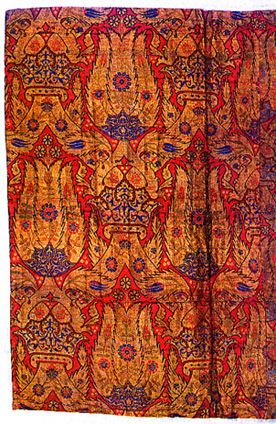
 Thanks,
Daniel
Thanks,
Daniel| Subject | : | Italian influence or interrelatedness? |
| Author | : | Daniel Deschuyteneer |
| Date | : | 06-07-2000 on 01:47 p.m. |
daniel.d@infonie.be
Dear all, I think we may not really speak of an "Italian" influence as the
influences were reciprocal and the designs used in the two countries,
especially in velvet and chatma fabrics, were interrelated. Here is some
information extracted from Nevber Gürsu's book concerning the Italian
influence in Ottoman art(p. 3; 165-9). During the 15th century, the Turks
achieved maturity in the political, as well in the cultural, social and
economic fields. At this time, silk fabrics were of great importance, not
only as commercial commodities but also as symbols of wealth and
magnificence. As the Anatolian Silk Roads were safe, Bursa developed into
an international commercial and industrial center of very considerable
importance for the trade between East and West. Bursa was visited by
merchants from Venice, Genoa, Florence and Iran for trade purposes. The
exchange of silk fabrics between the various countries resulted in
reciprocal influences in textile design. Ottoman Chatma fabrics were much
influenced by Italian products, a development which started in the 15th
century. In the following century, as the Ottoman art of weaving continued
to develop, Ottoman textiles began to influence the fabric design of other
countries. A number of motifs and styles, particularly in textile designs,
were common to both countries and Chatma fabrics were probably a common
product of the two countries. Only technical differences (type of metallic
threads, double pile velvet ground) and the restricted number of colors
(including the bright Turkish crimson red), permit sorting some Italian
and Ottoman chatma fabrics. Historical documents indicate that Italian
merchants settled in the district of Galata, in Istanbul. At the same
time, from the reign of Beyazit I onwards (1621 until 1838), Ottoman
merchants in Venice were granted special concessions, allowing them to
engage freely in commerce. They lodged and conducted their business in the
Casa del Ferrare. This building was later known as the "Fondaco dei
Turchi" Perhaps that our Italian friends can add some information. This
combination of Turkish technology and cheap labor with Venetian enterprise
came to dominate the European market. Turkish weavers and artists borrowed
the pomegranate and pineapple motifs from Italian fabric designs but
employed them in a unique way. Although these motifs disappeared from
Italian silks after 1525-1550 they continued to be employed in Turkish
fabrics throughout the 17th century. The most important motif inspired by
Italian designs was the crown, very often placed on the lattices forming
the medallion. Here are two photo (ill.63 & 71) of Nevber Gürsu's
book, showing the the crown motif in two pieces from the mid 16th century.
  Thanks,
Daniel Thanks,
Daniel |
| Subject | : | RE:Italian influence or interrelatedness? |
| Author | : | Michael Wendorf |
| Date | : | 06-07-2000 on 04:02 p.m. |
| Dear Daniel: Thank you for your labors in this Salon. Very helpful. In the cataloge to the Corcoran Exhibition there are several essays. One of these is by Tulay Artan. In his essay entitled "Periods, Functions, Messages", Artan writes that: when Mehmed II died in 1481, the empire that had built and consolidated over 30 years straddled two blocks of territory. One in Europe and one in Asia. The success in straddling these two worlds is reflected both in the Topkapi collections and their art which point to diverse origins, backgrounds and linkages: a Turcoman vein, heavily overlaid with a Chinese/Far East connection, a Timurid/West Asian connection, a Mamluk/classical Islam connection, and a Venetian/Italian connection rooted in the 13th and 14th centuries, when Venice and Genoa extended their economic influence and power in the Black Sea, the Aegean and the Eastern Mediterranean. It was through these new Italian zones of control that the Turcoman lords of Anatolia started learning about the sea. After 1453 it was with Venice that Mehmed II had to contend for hegemony. For centuries thereafter, Venice had a finger in virtually every anti-Ottoman alliance; Sultan and Doge kept clashing: at Preveza (1538), Lepanto (1571) etc. At the same time, they inevitably kept learning from and influencing one another... luxury goods and the craftsmen skilled in producing them flowed back and forth across frontiers. Many leading members of Ottoman elite placed a premium on Renaissance artists and artisans. This was clearly the attitude of the conqueror himself who, based on his early sketches seems to have been taken by western art. From 1461, when work on the Topkapi started to Mehmed's death in 1481, invitations went out from Istanbul to numerous painters, decorators and bronze workers, as well as specialists in the minor arts. Even during periods of war, 1463-79, artists from Rimini, Ragusa (Dubrovnik), Milan, Florence and Venice found their way to the Ottoman capital. This would seem to support your thesis of reciprocal influences between the Ottomans and Italians. Further, recall that the Topkapi collections include several Italian velvets from this period. Thanks, Michael |
| Subject | : | RE:Italian influence or interrelatedness? |
| Author | : | Daniel Deschyteneer |
| Date | : | 06-08-2000 on 12:56 a.m. |
| Dear Michael, It's not my thesis but the thesis developed by Nevber Gürsu in his book. I just share his thoughts. Daniel |